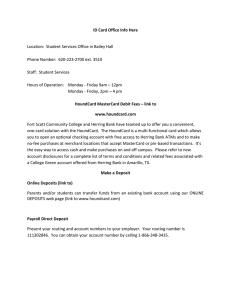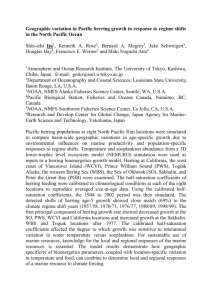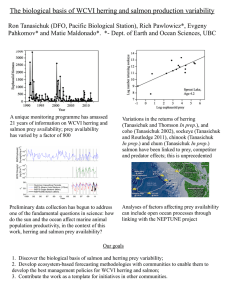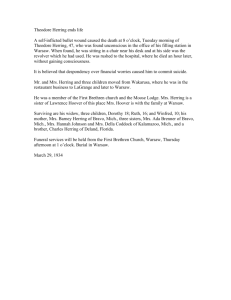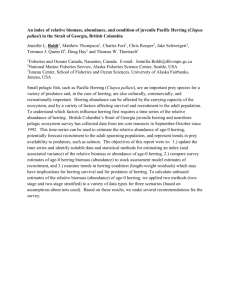Pelagic fish Committee
advertisement
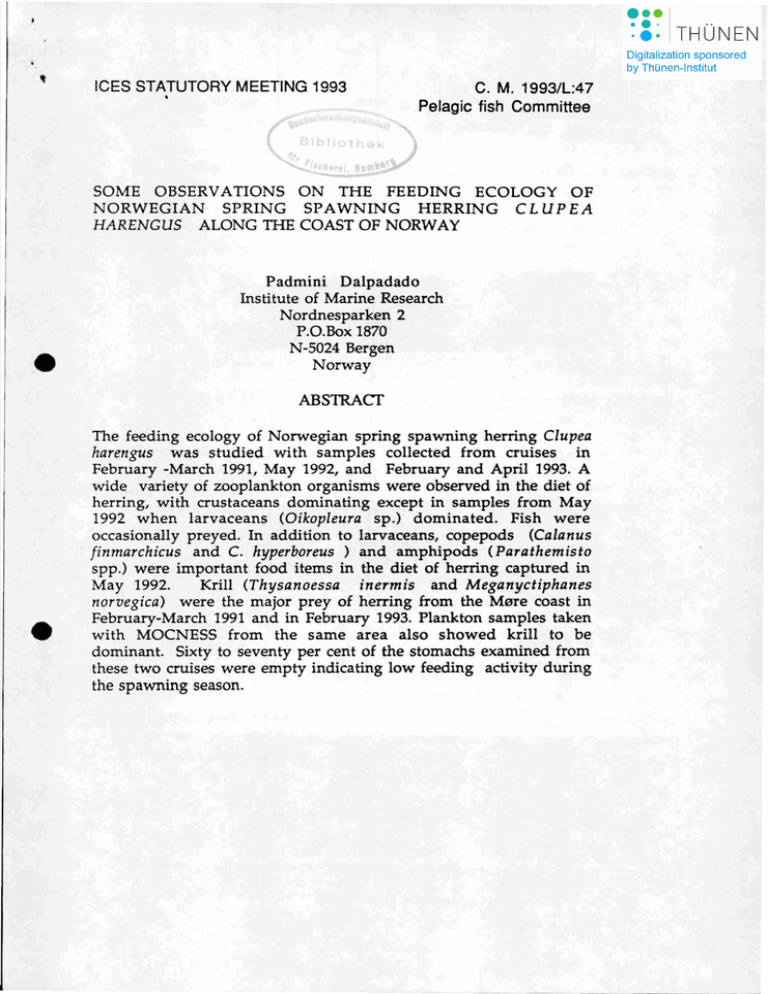
ICES STATUTORY MEETING 1993 • C. M. 1993/L:47 Pelagic fish Committee SOME OBSERVATIONS ON THE FEEDING ECOLOGY OF NORWEGIAN SPRING SPAWNING HERRING CLUPEA HARENGUS ALONG TIIE COAST OF NORWAY • Padmini Dalpadado Institute of Marine Research Nordnesparken 2 P.O.Box 1870 N-S024 Bergen Norway ABSTRACf The feeding ecology of Norwegian spring spawning herring Clupea harengus was studied with sampies collected from cruises in February -March 1991, May 1992, and February and April 1993. A wide variety of zooplankton organisms were observed in the diet of herring, with crustaceans dominating except in sampies from May 1992 when larvaceans (Oikopleura sp.) dominated. Fish were occasionally preyed. In addition to larvaceans, copepods (Calanus - finmarchicus and C. hyperboreus ) and amphipods (Parathemisto spp.) were important food items in the diet of herring captured in May 1992. Krill (Thysanoessa inermis and Meganyctiphanes were the major prey of herring from the Mere coast in norvegica) February-March 1991 and in February 1993. Plankton sampies taken with MOCNESS from the same area also showed krill to be dominant. Sixty to seventy per cent of the stomachs examined from these two cruises were empty indicating low feeding activity during the spawning season. , 1 Introd uctio n The Norwegian spring spawning herring (Clupea harengus ) stock was the largest fish stock in the North Atlantic before its collapse in the 1960's (Oragesund et al.,1980). Overlishing is regarded as the main cause for the almost extinction of this species. Since 1975 the stock has gradually recovered and the size of the spawning stock in 1992 was estimated to be approximately 2 million tons (R0ttingen, 1992, 1993). The general distribution and migratory patterns of Norwegian spring spawning herring before and after the collapse have been described by several authors (Oragesund and Ulltang, 1978; Dragesund et al. ,1980; Jakobsson, 1985 and R0ttingen, 1990, 1992). Following the collapse of the herring stock, changes in geographical distribution and timing of migration have being observed. These changes have resulted in variations in spawning and feeding seasons (R0ttingen, 1990). Before the collapse of the Norwegian spring spawning herring stock, the main feeding area was located between Iceland and Jan Mayen, whereas after the collapse the feeding area was restricted to the coastal waters of northern Norway (Nordland/Troms). As a consequence the feeding area of the adult herring and the drift area of larvae and O-group have coincided. Oue to the strong year classes in 1983 and in the most recent years, the stock size has increased and the feeding area has been observed to extend to the western part of the Norwegian Sea (R0ttingen, 1989, 1990). Crustaceans such as copepods, krill and amphipods have generally dominated the diet of adult herring in most studies carried out in the North Atlantic. In addition larvaceans, Ammodytes spp., fish larvae and fish eggs have also been found to be important in the diet of herring (Hardy, 1924; Ogilvie, 1934; Harding and Nichols, 1987; Last, 1989). Cannibalism could occur in the overlapping area between larval and older herring in the coastal waters of northern Norway, though the extent of this is poorly documented. Investigations carried out by Holst (1992) in the Lofoten area showed that in 5 out of 75 stations, young and adult herring had fed on O-group herring. In the current study food and feeding conditons of adult herring • 2 have been investigated along the coast 6f Norway~ The distribution of herring in ,relation to its prey 6rgi'misms, has also ceen investigated. Another area of investigation which I am addressing is whether herring also feeds on he~ring larvae and whether this could contribute to recruitment variation. MatEfrjalS, abd Methods Herdng Stomachs were collected from Mßre to Vesterälen during cruises with R/V I'G.O. Sars" in May 1992, Februa,y and April 1993 aria with R/V 'IMichael Sars" in February - March 1991. Locations of the sampling stations are illustrated in Figura 1. • x A Harstad trawl with 16 16 m moutt, openlng was used t6 catch herring. The trawl was 30 m long; with a mesh size of 8" rrim (stretched) at the cod ena. Tha towing speed of the ship at the time of trawling 'vVas 3 knots and the trawl depth varied usually from surfaee t6 100 m. The trawl was fitted with a Seanmar aepth sensor. " ~ Twenty to thirty individuals of herring were randomly selected fram the trawl cateh. Their lengths were measured t6 the naarest cm below. The stomachs ware removed, injeeted with 4% formalin and stored in small boUles with 4% formalin. The stomaeh eontents were subsequently. a.xamined in the laboratory at the Institute of Marine Research ,(IMR). For all speeimens the stomaeh fullness and the state of digestion of stomaeh contents were classifiea according to the scalE~s given in "Instruetions for sampling and c6dirig of fish data" (Anön., 1990). All food organisms present were reeorded. All intact prey organisms were identified to species and their lengths were rrieasiJred, to the naarest 0.2 mm, using an oeular mierometer. Stages of development of cepeoas and krill ware also noted. Data on age and maturity stages of herring used for this study were obtained from the Reseuree Center at the IMR. For some of the cruisesi the dry weight of the stomach contents was measured. The major prey ccltegories were weighed separately whila the rest were weighed togather in another batch. Dry waight of the stomae~ content was obtained by keeping the sampies in a 3 drying oven at 80°C tor two days (usually) or until a constant weight was obtained. During most cruises, plankton sampies were also taken using WP2 nets, Juday nets and MOCNESS. At present only apart ot this material has been analysed. Results A wide variety of zooplankton organisms were observed in the diet of herring. Crustaceans were the dominant prey category except in the sampies from May 1992 when larvaceans (Oikop/eura s p.) dominated (Fig. 2, Table 1). In addition to larvaceans, copepods Ca/anus finmarchicus and C. hyperboreus and amphipods Parathemisto spp. were important prey in the diet of herring caught trom Lofoten/Vesterälen. Fish (Maurolicus muellen) were also recorded occasionally (Fig. 2, Table 1). Most of the analysed stomach sampies are trom the cruises in February-March 1991 and 1993, covering the herring spawning grounds in the M0re and Romsdal area. Three hundred and sixty eight and two hundred and six stomachs of herring, respectively, have been analysed from the two years. A high percentage of empty stomachs (59%) was observed in herring caught in February-March of 1991. The ones that fed had preyed mainly on krill (820/0 by numbers) (Fig. 2, Table 2). The dominant krill species were Thysanoessa inermis and Meganyctiphanes norvegica. Similar results were obtained from the February 1993 cruise in the same area when krill (mainly T. inermis ) comprised 99% of herring stomachs by weight (Fig. 2, Table 3). Fish eggs, most probably of Norway pout (Trisopterus esmarkii ) or saithe (Pollachius virens ) (0.5% by weight), were also found. Plankton sampies from M0re in February-March 1991 using a MOCNESS ( fraction above 2000 J.l.m) showed krill to be important with a mean of 31.9% (range 10-93% , n=7) by numbers. Though copepods were higher in numbers in most stations, krill and star fish larvae dominated in biomass. A high percentage ot empty stomachs (60-72%) in February- March • 4 incficates low feeding activity during the spawning season. Äbout 57% of the fishes caught in February-March 1991 were mature 87% were mäture in February (maturity stages 4 and 5);. whereas 1 ~93; In May 1992 only 70/0 öf the fishes, had empty st~nriachs. Most of the tishes trom ,May had stornach tullness öf 3 (Iittle contents) and 4 (stornach full); T.he sampies from April 1993 are presently being analysed; Preliminary analysis of data from this cruise indicated that krill was -the principal food of herring at M"re. • Most of the herring caught in February-March 1991 were of the 1983 year das.s and ranged between 25 arid 35 cm in 1991 and 30 to 37. cm in 1993 (Rßttingen, 1991 ~md unpublished data). The size of herring caught in May 1992 varied from 25 to 37 cm. DjsCLJ$sjOO Diurnal variation in diet could not be examined in the present study as only catches from night time ware , available~ Previous efforts to catch herring during day time with Harstad trawl" have yielded very low eatches, possibly due to visual avoidance of the trawl by herring. The trawl has a small mouth opening and is operated 8.t relatively low töwing speed (3 knots). Ä new trawl ("AkratrAlen") with a eomparatively large mouth opening and mesh size will be tested in coming cruises. The present analysis of stornach contents of adult herring (2-12 years) showed that eopepods j krill, amphipods, larvaceans, fish eggs ete. were the most important prey in the diet. Ogilvie (1934), Hardirig arid Nichols (1987), Last (1989) and other researchers made similar obserVations on herring from the North Atlantic. ,Quantifying predation on herring eggs and larvae by adults; needs intensive sampling from the overlapping areas between .pr~y ancf predator. Rapid analyses of storriach conterits are also irriportarit as the presence of herring larvae iri the stomaehs of fish might be difficult to detect due to fast digestion (Balfoort, 1984). In the present study, herring occasionally preyed on fish arid fish egg5. The fish that eould be identifed was Maufolicus muellefi and the fish eggswere of gadoids. Herring feecUng on herring laniae could cause variations in recruitrnent. I did not, however, find any herring 5 eggs or larvae in the diet of adult herring. Holst (1992) suggested that cannibalism might be a regulating factor for year class strength in the Norwegian spring spawning herring. Nicol and Harding (1987) have investigated the predation on planktonic fish eggs and larvae by fish predators. They found pelagic fish to be important predators of fish eggs and larvae. Their study showed that the diet of herring (3-24 cm) consisted of 0.3% fish eggs, 17.8% larvae and 6. 2% young fish. Dietary differences were observed in herring caught from different regions and seasons. Krill (T. inermis, M. norvegica ) was the principal food of herring at Mare in February- March. Herring caught in the Lofoten/Vesterälen region in May took larvaceans, copepods and amphipods as their major prey. Analyses of plankton sampies from the Mare region from February-March 1991 showed that krill was a major component among the micronekton and macroplankton organisms (Meile et al. 1993 and unpublished data). High abundances (0.1-0.5 numbers per m3 ) of krill were observed during day time at depths of 250-600 meters outside the continental shelf (Meile et al. 1993) . Last (1989) did not find any marked differences in the diet between the smaller and larger herring (10-34 cm). The size of herring used in the present study ranged from 21 to 38 cm. As in Last's study no clear ontogenetical variations in the diet of herring with size were observed. 6 References Anon. (1990). Instruks for pmvetaking og koding av fiskedata~ Havforskriingsinst., Bergen,140 pp. Balfoort, H. (1984). Experln1ents on digestion rate of herring larvae in fish stomachs. ICES C. M. 1984/H:32, 4. pp. Dragesund, b. , Hamre, J,.and Ulltang, 0. (1980); Siology and, population dynamics of the Norwegiari spring;;.spawning herring. Rapp. P.-V. Cons. Reun. int. Explor. Mer , 177:43.;.71 Dragesurid, O. arid. Ulltang, 0. (1978). Stock size fluctuations and rate of exploitation of thö Norwegian spring spawning h~rring, 1950-1974. Fisk. Dir. Skr. Sero HavUnders~, 16:315.;. 337 : Harding, D. and Nichols, J. H. (1987). Plankton. surveys off the north~east coast cif England in 1976; an Introductory report and summary of results., Fish. Res. Tech. Rep. MAFF Direct. Fish. Res. Lowestoft.; 86. 56 pp. Hardy, M. A. (1924); The herring in relation to its animate environment. Part. 1. The food and feeding habits of the herring with special referEmce t6 the east coast of England~ Fisheries Investigätions, 7(3):1-53 Holst, J~ Chr.. (1992). Cannibalism as a factor regulating year class strerigth in the Norwegian spring.;.spawning herring stock. ICES C.M. 19921H:14, 10 pp. Jakobsson" J. (1985). Monitoring and management of the t;Jortheas~ AtI~iI,tic herring stocks. Carl. J. Fish~ Aqual. Sei. 42:207-221 Last, J. M~ (1989)., The food of herring, Clupea harengus, in the North Sea. J. Fish. BioI. 34,489-501 Meile; W., Knutsen, T., Eller1sen, B., KaartVedt , S. and Noji, T~ (1993); 0kosYste.met i "silige Norskehavet; Sokkei og dyphav. Havforskningsinstituttet, rapp. Nr. 4, 108 pp. 7 Ogilvie, H. S. (1934). A preliminary account of the food of the herring in the north-western North Sea. Rapp. P.-v. Cons. Reun. int. Explor. Mer, 89:85-92 R0Uingen, I. (1989). The 1983 year class of the Norwegian spring spawning herring as juveniles and recruit spawners. Proceedings of the fourth Soviet-Norwegian Symposium, Bergen, 12-16 June 1989, 165-203 R0ttingen, I. (1990). A review of variability in the distribution and abundance of Norwegian spring spawning herring and 8arents Sea capelin. Polar Research, 8: 33-42 R0Uingen, I. (1991). Norsk värgytende sild - vintersildunders0kelser 1991. Havforskningsinst., Intern toktrapport 6/1991, 18 pp. • R0ttingen, I. (1992). Recent migration routes of Norwegian spring spawning herring. ICES CM 19921H:18, 8 pp. R0Uingen, I. (1993) Norsk värgytende sild oversikt 1993. Fisken og Havet, 1:7-11 in ""Ressurs • • • 1991 • 1992 o 1993 February o .. April • 15° Fig. 1. Locations of pelagic trawl stations. Legend "G.D. Sars" May 1992, "M. Sars", 0 = February 1993 , February -March 1991. 0 • = = April 1993, R/V • = R/V N-lSO I = 23,5-37.5 mm STOMACH COi'ITENT BY NUMBERS "M. SARS- FEB. 1991 2,14 ... 0.49 ... 71,86 ... 99.44 % N = 16 N=23 1= 32.5-37 mm I = 25-37 nun STOMACH CONTENT BY WEICHT '·G.O.5ARS·· FEB. 1993 STOMACH CONTENT BY WEIGJ-IT '"G.O.5ARS- MAY 1992 • AMPHIPODS Pa COPEPODS ~ ~ flSH flSHEGGS KRILL ~ OTHERS o[TI LARVACEANS Fig. 2. Principal food organisms of herring as percentages of the total number or weight. Empty stomaehs not included. • Table 1. Dlet composition of herring from LofotenNesterälen, May 1992; prey Items In numbers. (s. c••stomach contents) St.no 300 301 302 303 312 318 320 No. of No. Itomachs empty 18 13 6 2 1 1 58 2 1 0 0 0 Rsh length Wet wt. of I.C. KRIll. range (ern) range (mg) T.lnermls M. norveg 00 data 102·1400 2 1 no data 313·1960 0 1 30·37 25-35 34 0 no data 4 29 433·1230 1737-2002 2941 29·1973 0 1 0 0 0 0 0 0 0 0 0CftRX)S T.longl damaged 0 12 0 0 4 0 1 8 6 9 18 0 0 2 CaIaRJs other. damaged 35 125 31 4 16 255 8 475 48 0 322 192 0 80 0 0 0 168 0 101 AMPHP. F&t lAAVACEA Oll-ERS total prey 5 2 2 2 59 0 30 232 91 764 415 338 0 335 89g. larvae adults ! 54 19 15 24 3 0 33 0 0 0 0 0 0 0 0 0 0 0 0 0 0 2 0 0 0 0 0 0 + + + + + + + Table 2. Diet composition of herring from M0re, February-March 1991; prey Items In numbers. (5. c.-stomach eontents) St.no No. of stomaehs No. empty 26 29 31 32 33 34 35 37 38 39 40 41 42 43 44 45 46 47 48 20 20 20 20 20 20 20 20 20 20 20 20 20 20 20 20 8 20 20 19 19 5 16 13 3 18 6 20 20 20 15 4 16 6 6 0 5 7 Fish length Wet wt. of I.C. KRILL OOPEPCOO MPHIP. ~ ~TO~L range (em) range (mg) T.lnermls M. norveg damaged Ca/anus others damaged eg95 larvae adults pfey 23.5-29.5 28.0-36.5 31.5-35.0 33.0-37.0 33.5-36.5 33.5-35.0 32.5-35.0 32.5-36.0 33.0-35.0 33.0-35.0 33.5-36.0 33.0-35.0 21.0-35.0 29.5-35.5 26.5-37.5 30.0-35.0 33.5-35.0 33.0-35.0 31.5-36.0 95 159 30-9485 259-2162 20-3960 55-12303 179-213 37-5799 191-608 143-4991 170-2046 124-8482 98-11840 88-8647 165-4430 46-3016 0 0 394 40 1 395 0 200 0 0 0 0 45 17 7 97 169 112 16 1 0 48 3 0 0 0 0 0 0 0 0 42 0 60 42 1 8 11 0 1 442 19 88 30 2 182 0 0 0 10 106 6 36 27 6 37 69 0 0 0 0 0 1 0 23 0 0 0 22 0 0 0 79 60 0 0 0 0 0 0 0 0 0 0 0 0 0 0 0 0 0 0 0 0 0 0 0 8 0 0 1 0 50 0 0 0 183 21 0 0 98 54 0 0 0 0 0 0 0 1 0 1 0 0 0 1 0 1 0 1 0 0 0 0 0 0 0 0 0 0 0 0 0 0 0 0 0 0 0 0 0 0 0 0 0 0 0 0 0 0 0 0 0 0 0 0 0 0 0 0 0 0 0 1 0 0 0 0 0 0 0 0 0 0 0 0 0 0 0 0 0 0 0 0 0 8 0 2 0 0 0 0 0 0 0 3 0 0 0 1 1 893 62 89 436 2 458 0 0 0 216 214 24 103 344 290 157 96 - Table 3. Diel composilion of herring trom M0re, February1993; prey ilems In numbers. (s. c.=slomaeh conlenls) Stno 99 100 101 102 103 104 105 No. No. of slomaehs emply 30 30 30 29 30 14 14 26 30 23 30 30 21 17 Fish lenglh Wel wt. of I.C. KRIll. range (em) range (mg) T.lnermls M. norveg 33.0-37.5 0 0 34.0-37.0 0 0 49 34.0-38.0 45-5150 29 19 31.5-37.0 111·4352 27 15 30.5-37.5 0 0 53·5042 32.5-37.0 253 64·18400 0 26.5-36.5 3 0 39·3780 <XlPEPCn; damaged 0 0 311 193 136 208 178 Calanus olhers damaged 0 0 0 0 0 0 0 0 0 0 0 0 0 1 18 0 0 0 6 0 0 AMPHP. RSH 0 0 0 0 0 0 0 89gs larvae adulls 0 0 0 0 0 0 0 0 0 0 0 0 12 0 0 204 0 0 112 0 0 OIl·ERS TqTAL prey 0 + + 360 1 0 235 0 762 666 1 0 299
